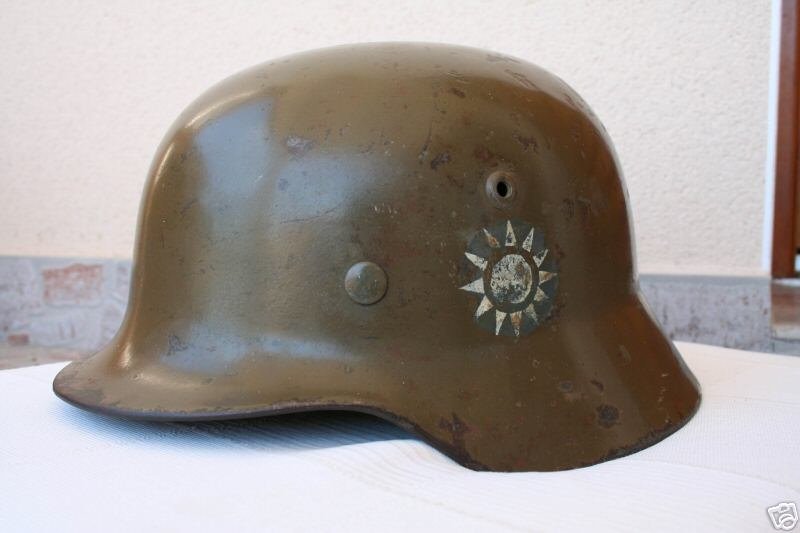Sunday, July 01, 2007
普魯士士官皮帽PRUSSIAN JAGER RIFLEMAN EM/NCO SHAKO


普魯士士官皮帽.帽前為普魯士鷹.
The origins of the distinctive Shako has been somewhat shrouded with the passing of time with some military historians accrediting the French with its development in the 1780's, based on the design of the civilian top hat, while others acclaim that it was based on the Austro-Hungarian or Bavarian Casquette headgear that was introduced at roughly the same time. It is known, however, that the Shako was originally adopted by the Prussian army as a experimental model in 1801 and was the standard headgear utilized by Jager and Schzen personnel during the Napoleonic Wars. The 1801 pattern shako went through numerous modifications and in March 1854 a new pattern was officially adopted by Jager and Schnelle Truppen, (Light Infantry and Mobile Troops), personnel. Further minor modifications to the Shako occurred in 1860, 1888, 1891, 1892, 1895, 1897, and 1915. The Shako continued in use with additional modifications for the German police through the post-war Weimar era and on into the Third Reich period.
Nice quality, 1915 pattern, blackened lacquered leather construction Jager EM/NCO Shako with magnetic sheet metal fittings. The body of the Shako has an extruding, humped curve reverse with downward sloping front and rear leather visors and a circular "coffee can" style top. Both the front and rear visors are secured to the Shako by a row of horizontal machine stitching along the bottom edge of the body. The circular, "coffee can", style top is also secured to the Shako by a row of horizontal stitching. Each side of the Shako body has a small, inset, circular, black painted, magnetic sheet metal panel with seven punched "salt & pepper" style ventilation holes to each positioned just below the crown seam. The front center of the Shako has the standard 1914 pattern, stamped, magnetic sheet metal, Prussian EM/NCO helmet plate. The helmet plate features the crowned Prussian eagle with upswept wings, clutching a royal scepter and a royal orb with an embossed scripted banner superimposed on its wings and breast. The embossed script to the banner consists of, "Mit Gott F Koenig und Vaterland", (With God for King and Fatherland), and has the royal, "FR" cypher to its breast indicating, Friedrich Rex, (King Friedrich). The helmet plate is attached to the Shako by two metal loops which extend into the interior through corresponding holes to the front. The eagle shows nice detailing and is nicely convexed to fit the contours of the Shako. The front center of the Shako also has a small, horizontal slash to accommodate the state field badge retaining wires. The state field badge is included and consists of a carved , vertically oval wooden base with an outer white cotton covering encompassing a central black wool covering. The badge has an extended looped wire protruding from the bottom edge which was designed to be inserted into the horizontal cut-out slot positioned at the front center of the Shako above the helmet plate. The Shako has the extended, magnetic sheet metal, M1891 pattern chinstrap retaining side posts positioned on each side of the body. The right side chinstrap retaining post has a circular, fluted magnetic sheet metal, painted, national tri-color cockade. The cockade features a fine black outer stripe, a fine white inner stripe and a red central field. The paints are fully retained. The blackened leather chinstrap is included and has two rectangular, magnetic sheet metal, sliding length adjustment buckles and is looped at either end and stitched to the reverse of the adjustment buckles. The interior of the Shako has a natural tan, grained leather, nine finger, liner fully intact with the original tie string. The liner shows light chafe wear but the leather is still fairly supple. The balance of the interior is in age darkened natural tan leather and the crown is well marked with a faint black size inkstamp, "55", date, "1916", and an illegible manufacturers mark. The Shako is in overall good condition with a few scuffs and scrapes and light to moderate surface cracking and scarring to the black lacquered finish. The metal fittings appear to have had a coat of clear protective lacquer applied and have taken on a flat bluish/grey appearance. Nice example.

